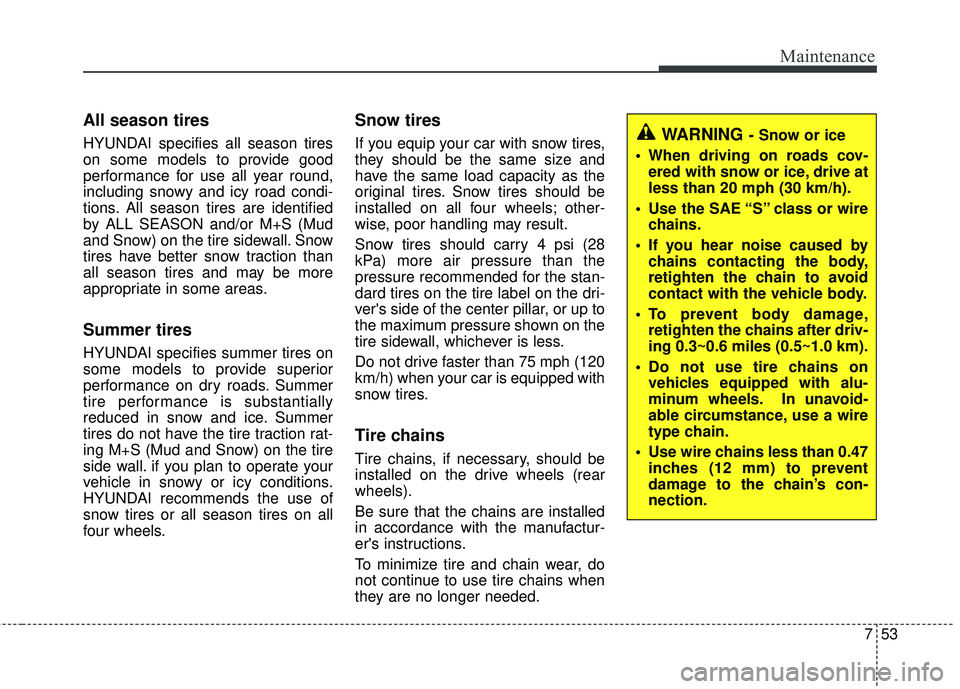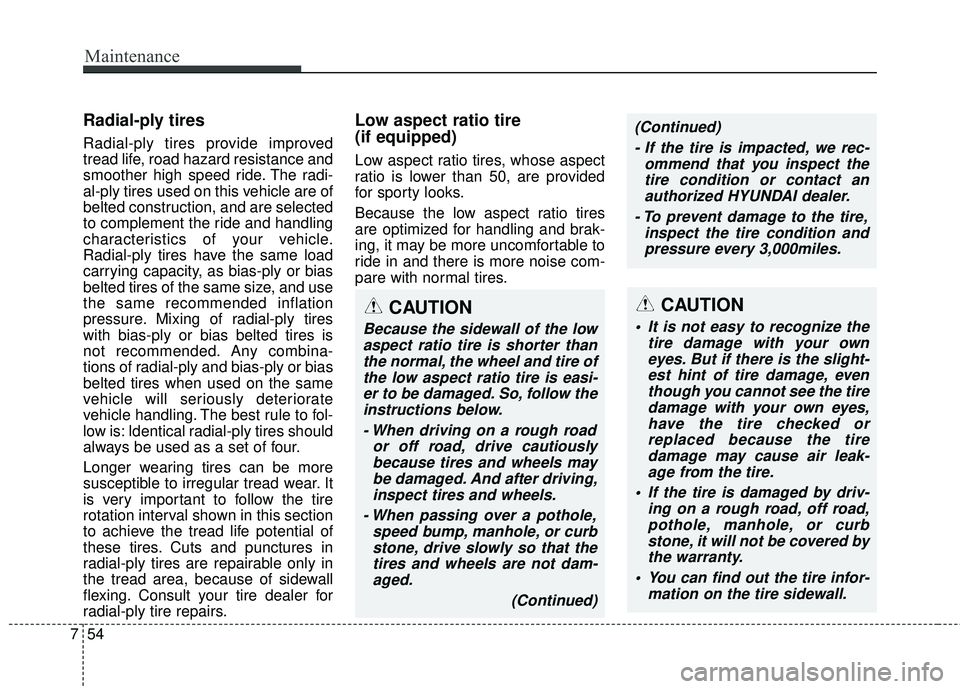2016 HYUNDAI GENESIS COUPE ULTIMATE load capacity
[x] Cancel search: load capacityPage 422 of 475

753
Maintenance
All season tires
HYUNDAI specifies all season tires
on some models to provide good
performance for use all year round,
including snowy and icy road condi-
tions. All season tires are identified
by ALL SEASON and/or M+S (Mud
and Snow) on the tire sidewall. Snow
tires have better snow traction than
all season tires and may be more
appropriate in some areas.
Summer tires
HYUNDAI specifies summer tires on
some models to provide superior
performance on dry roads. Summer
tire performance is substantially
reduced in snow and ice. Summer
tires do not have the tire traction rat-
ing M+S (Mud and Snow) on the tire
side wall. if you plan to operate your
vehicle in snowy or icy conditions.
HYUNDAI recommends the use of
snow tires or all season tires on all
four wheels.
Snow tires
If you equip your car with snow tires,
they should be the same size and
have the same load capacity as the
original tires. Snow tires should be
installed on all four wheels; other-
wise, poor handling may result.
Snow tires should carry 4 psi (28
kPa) more air pressure than the
pressure recommended for the stan-
dard tires on the tire label on the dri-
ver's side of the center pillar, or up to
the maximum pressure shown on the
tire sidewall, whichever is less.
Do not drive faster than 75 mph (120
km/h) when your car is equipped with
snow tires.
Tire chains
Tire chains, if necessary, should be
installed on the drive wheels (rear
wheels).
Be sure that the chains are installed
in accordance with the manufactur-
er's instructions.
To minimize tire and chain wear, do
not continue to use tire chains when
they are no longer needed.
WARNING- Snow or ice
When driving on roads cov- ered with snow or ice, drive at
less than 20 mph (30 km/h).
Use the SAE “S” class or wire chains.
If you hear noise caused by chains contacting the body,
retighten the chain to avoid
contact with the vehicle body.
To prevent body damage, retighten the chains after driv-
ing 0.3~0.6 miles (0.5~1.0 km).
Do not use tire chains on vehicles equipped with alu-
minum wheels. In unavoid-
able circumstance, use a wire
type chain.
Use wire chains less than 0.47 inches (12 mm) to prevent
damage to the chain’s con-
nection.
Page 423 of 475

Maintenance
54
7
Radial-ply tires
Radial-ply tires provide improved
tread life, road hazard resistance and
smoother high speed ride. The radi-
al-ply tires used on this vehicle are of
belted construction, and are selected
to complement the ride and handling
characteristics of your vehicle.
Radial-ply tires have the same load
carrying capacity, as bias-ply or bias
belted tires of the same size, and use
the same recommended inflation
pressure. Mixing of radial-ply tires
with bias-ply or bias belted tires is
not recommended. Any combina-
tions of radial-ply and bias-ply or bias
belted tires when used on the same
vehicle will seriously deteriorate
vehicle handling. The best rule to fol-
low is: Identical radial-ply tires should
always be used as a set of four.
Longer wearing tires can be more
susceptible to irregular tread wear. It
is very important to follow the tire
rotation interval shown in this section
to achieve the tread life potential of
these tires. Cuts and punctures in
radial-ply tires are repairable only in
the tread area, because of sidewall
flexing. Consult your tire dealer for
radial-ply tire repairs.
Low aspect ratio tire
(if equipped)
Low aspect ratio tires, whose aspect
ratio is lower than 50, are provided
for sporty looks.
Because the low aspect ratio tires
are optimized for handling and brak-
ing, it may be more uncomfortable to
ride in and there is more noise com-
pare with normal tires.
CAUTION
Because the sidewall of the low
aspect ratio tire is shorter thanthe normal, the wheel and tire ofthe low aspect ratio tire is easi-er to be damaged. So, follow theinstructions below.
- When driving on a rough road or off road, drive cautiouslybecause tires and wheels maybe damaged. And after driving,inspect tires and wheels.
- When passing over a pothole, speed bump, manhole, or curbstone, drive slowly so that thetires and wheels are not dam-aged.
(Continued)
CAUTION
It is not easy to recognize thetire damage with your owneyes. But if there is the slight-est hint of tire damage, eventhough you cannot see the tiredamage with your own eyes,have the tire checked orreplaced because the tiredamage may cause air leak-age from the tire.
If the tire is damaged by driv- ing on a rough road, off road,pothole, manhole, or curbstone, it will not be covered bythe warranty.
You can find out the tire infor- mation on the tire sidewall.
(Continued)
- If the tire is impacted, we rec- ommend that you inspect thetire condition or contact anauthorized HYUNDAI dealer.
- To prevent damage to the tire, inspect the tire condition andpressure every 3,000miles.
Page 424 of 475

755
Maintenance
FUSES
A vehicle’s electrical system is pro-
tected from electrical overload dam-
age by fuses.This vehicle has 3 fuse panels, one
located in the driver’s side panel bol-
ster, the others in the engine com-
partment.
If any of your vehicle’s lights, acces-
sories, or controls do not work, check
the appropriate circuit fuse. If a fuse
has blown, the element inside the
fuse will be melted.
If the electrical system does not
work, first check the driver’s side
fuse panel.
Always replace a blown fuse with
one of the same rating.
If the replacement fuse blows, this
indicates an electrical problem. Avoid
using the system involved and imme-
diately consult an authorized
HYUNDAI dealer.
Three kinds of fuses are used: blade
type for lower amperage rating, car-tridge type, and fusible link for higheramperage ratings.
OBK079042
Normal
Normal
Blade type
Cartridge type
Fusible link Blown
Blown
Normal Blown
WARNING - Fuse replace-
ment
Never replace a fuse with any- thing but another fuse of the
same rating.
A higher capacity fuse could cause damage and possibly a
fire.
Never install a wire or alu- minum foil instead of the prop-
er fuse - even as a temporary
repair. It may cause extensive
wiring damage and a possible
fire.
CAUTION
Do not use a screwdriver or anyother metal object to removefuses because it may cause ashort circuit and damage thesystem.
Page 474 of 475

Index
10I
Steering wheel··················\
··················\
··········· ·4-33
Horn ··················\
··················\
··················\
· ·4-34
Power steering ··················\
··················\
······· ·4-33
Tilt & Telescope steering ··················\
··············4-34
Steering wheel audio control ··················\
···········4-129
Steps For Determining Correct Load Limit ··············5-53
Storage compartment ··················\
··················\
· ·4-120
Center console storage ··················\
···············4-120
Glove box ··················\
··················\
··········· ·4-120
Luggage net ··················\
··················\
········· ·4-126
Sunglass holder ··················\
··················\
···· ·4-121
Sunglass holder ··················\
··················\
·········4-121
Sunroof ··················\
··················\
··················\
· ·4-30
Sunvisor ··················\
··················\
·················4-123
Tachometer ··················\
··················\
·············· ·4-47
Tether anchor system ··················\
··················\
··· ·3-32
Theft-alarm system ··················\
··················\
····· ·4-14
Tilt & Telescope steering ··················\
················ ·4-34
Tire and loading information label ··················\
······5-52
Tire chains ··················\
··················\
··············· ·5-49
Tire pressure monitoring system (TPMS) ·················6-7
Tire specification and pressure label ··················\
·····8-7
Tires and wheels ··················\
··················\
··· ·7-41, 8-3
Checking tire inflation pressure ··················\
······7-42
Compact spare tire replacement ··················\
······7-46Recommended cold tire inflation pressures
··········7-41
Tire care ··················\
··················\
·············· ·7-41
Tire maintenance ··················\
··················\
···· ·7-47
Tire replacement ··················\
··················\
····· ·7-45
Tire rotation ··················\
··················\
·········· ·7-43
Tire sidewall labeling ··················\
················· ·7-47
Tire traction ··················\
··················\
·········· ·7-47
Wheel alignment and tire balance ··················\
···7-44
Wheel replacement ··················\
··················\
·· ·7-46
Towing ··················\
··················\
··················\
· ·6-20
Removable towing hook ··················\
··············6-21
T
owing capacity ··················\
··················\
········· ·5-53
Towing hook ··················\
··················\
··············6-21
TPMS ··················\
··················\
··················\
···· ·6-7
Trailer Towing ··················\
··················\
··········· ·5-58
Trip computer ··················\
··················\
··········· ·4-50
Trunk · · · · · · · · · · · · · · · · · · · · · · · · · · ··················\
··············4-20
Trunk emergency safety release ··················\
·········4-21
Trunk room lamp ··················\
··················\
······· ·4-90
Ttranmission Automatic tranmission ··················\
················ ·5-17
Manual tranmission ··················\
··················\
· ·5-13
USB device ··················\
··················\
············ ·4-166
User setting mode ··················\
··················\
······ ·4-53
T
U
Page 475 of 475

I11
Index
Vanity mirror lamp··················\
··················\
····· ·4-90
Vehicle break-in process ··················\
··················\
·1-5
Vehicle capacity weight ··················\
··················\
·5-52
Vehicle certification label ··················\
··················\
8-6
Vehicle curb weight ··················\
··················\
···· ·5-57
Vehicle data collection and event data recorders ·········1-7
Vehicle identification number (VIN) ··················\
·····8-6
Vehicle load limit ··················\
··················\
······· ·5-52
Cargo capacity ··················\
··················\
······· ·5-53
Certification label ··················\
··················\
··· ·5-55
Seating capacity ··················\
··················\
····· ·5-52
Steps For Determining Correct Load Limit ··········5-53
Tire and loading information label ··················\
···5-52
Towing capacity ··················\
··················\
····· ·5-53
Vehicle capacity weight ··················\
···············5-52
Vehicle weight ··················\
··················\
·········· ·5-57
Base curb weight ··················\
··················\
···· ·5-57
Cargo weight ··················\
··················\
········· ·5-57
GAW (Gross axle weight) ··················\
·············5-57
GAWR (Gross axle weight rating) ··················\
···5-57
GVW (Gross vehicle weight) ··················\
·········5-57
GVWR (Gross vehicle weight rating) ·················5-57
Vehicle curb weight ··················\
··················\
· ·5-57
VIN number ··················\
··················\
················8-6
Volume/weight ··················\
··················\
·············8-3 Walk in device
··················\
··················\
·········· ·3-12
Warning and indicators ··················\
··················\
·4-62
Washer fluid ··················\
··················\
··············7-30
Weight/volume ··················\
··················\
············ ·8-3
Welcome function ··················\
··················\
······ ·4-84
Wheel alignment and tire balance ··················\
·······7-44
Wheel replacement ··················\
··················\
····· ·7-46
Windows ··················\
··················\
················· ·4-22
Auto up/down window ··················\
··············· ·4-23
Windshield defrosting and defogging ··················\
·4-115
Defogging logic ··················\
··················\
···· ·4-118
W
inter driving ··················\
··················\
··········· ·5-48
Snow tires ··················\
··················\
············ ·5-48
Tire chains ··················\
··················\
············ ·5-49
Wiper blades ··················\
··················\
··············7-35
Wipers and washers ··················\
··················\
···· ·4-87
VW